-

人教版高中英语必修5The United Kingdom说课稿4篇
Teaching Aims:Knowledge 1. Get the students to learn the useful new words and expressions in this section. Aims:2. Let the students learn about how the UK was formed and the four groups of invaders.1. Develop students’ reading ability and let them learn different Ability reading skills. Aims:2. Enable students to learn to talk about the United Kingdom and the Union Jack Emotional 1. Let students know more about the UK2. Develop students’ sense of cooperative learning Aims:Teaching Important Points:1. Let the students learn about the countries of the United Kingdom and the Union Jack2. Get the students to read the passage and know about how the UK was formed and the four groups of invaders.3. Have the students learn different reading skills.Teaching Difficult Ponts:1. Develop students’ reading ability.2. Enable students to talk about the United Kingdom and the Union Jack.3. Let students learn how the UK was formed geographically and historically.Teaching Methods:Showing pictures, asking, exercising, listening, reading etc.Teaching Aids:A computer,a projector and a blackboard.Teaching Procedures: 1) Show a map of the world, ask students the following questions:Where is the UK?What’s the full name of the UK?2) Ask the students work in pairs to do the quiz on Page 9.Do you want to test how many things you know about the United Kingdom? Let’s have a small test.Using the map on P9, students answer the following questions:?How many countries does the UK consist of? What are they??England is divided into three main areas. Do you know what they are? 1) Scanning (10Minutes )Let the students hold the questions asked in pre-reading and read the passagequickly and then let them do the following exercise.Join lines to the right answer.
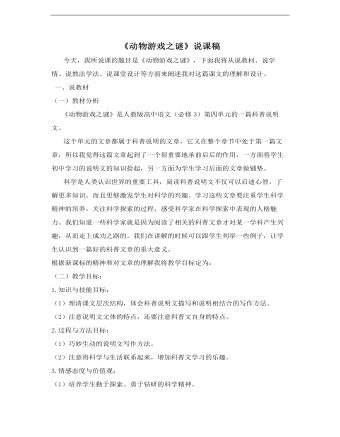
高中语文人教版必修三《动物游戏之谜》说课稿
科学是人类认识世界的重要工具,阅读科普说明文不仅可以启迪心智,了解更多知识。而且更够激发学生对科学的兴趣。学习这些文章要注重学生科学精神的培养,关注科学探索的过程,感受科学家在科学探索中表现的人格魅力。我们知道一些科学家就是因为阅读了相关的科普文章才对某一学科产生兴趣,从而走上成功之路的。我们在讲解的时候可以跟学生列举一些例子,让学生认识到一篇好的科普文章的重大意义。
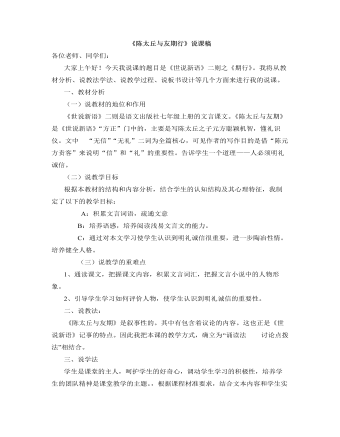
部编版语文七年级上册《陈太丘与友期行》说课稿
各位老师、同学们:大家上午好!今天我说课的题目是《世说新语》二则之《期行》。我将从教材分析、说教法学法、说教学过程、说板书设计等几个方面来进行我的说课。一、教材分析(一)说教材的地位和作用《世说新语》二则是语文出版社七年级上册的文言课文。《陈太丘与友期》是《世说新语》“方正”门中的,主要是写陈太丘之子元方聪颖机智,懂礼识仪。文中 “无信”“无礼”二词为全篇核心,可见作者的写作目的是借“陈元方责客”来说明“信”和“礼”的重要性。告诉学生一个道理——人必须明礼诚信。(二)说教学目标根据本教材的结构和内容分析,结合学生的认知结构及其心理特征,我制定了以下的教学目标:A:积累文言词语,疏通文意B:培养语感,培养阅读浅易文言文的能力。
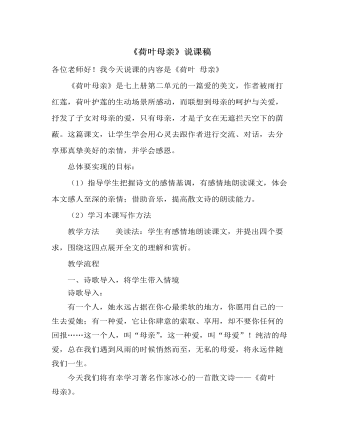
部编版语文七年级上册《荷叶·母亲》说课稿
各位老师好!我今天说课的内容是《荷叶 母亲》 《荷叶母亲》是七上册第二单元的一篇爱的美文,作者被雨打红莲,荷叶护莲的生动场景所感动,而联想到母亲的呵护与关爱,抒发了子女对母亲的爱,只有母亲,才是子女在无遮拦天空下的荫蔽。这篇课文,让学生学会用心灵去跟作者进行交流、对话,去分享那真挚美好的亲情,并学会感恩。总体要实现的目标: (1)指导学生把握诗文的感情基调,有感情地朗读课文,体会本文感人至深的亲情;借助音乐,提高散文诗的朗读能力。(2)学习本课写作方法教学方法 美读法:学生有感情地朗读课文,并提出四个要求,围绕这四点展开全文的理解和赏析。
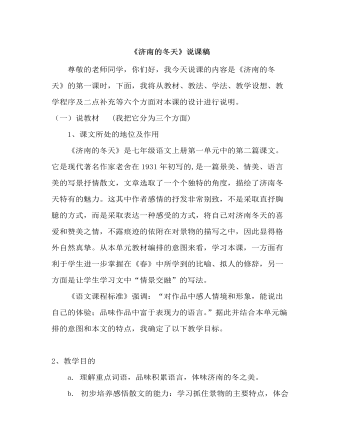
部编版语文七年级上册《济南的冬天》说课稿
这节课我是按“引入新课——讲授新课——反馈练习——归纳总结”进行教学的。 1、引入新课:我先对布置的预习作业进行抽查并明确生字词答案;然后以简洁的话语引入新课,情境导入一年有四季,季季有特色。今天我们单表一下多姿的冬天。和学生一起欣赏燕京一带冬天雪花,感受边塞冬天的奇寒;东北的冬天,云南的冬天。引出素有“泉城”之称的济南,冬天又是怎样的呢?今天,就让我们追逐老舍先生的足迹,到济南去看一下冬天的景象,感受一下冬天的气息。(这时用课件对作者及与课文有关的经历进行介绍) 2、讲授新课:在讲授前,让学生带着问题对课文进行朗读,使学生感知课文,问题用课件打出如下: a、为什么说济南是个“宝地”? b、济南是有山有水的地方,文中写了三幅山景图,还写了水色,各突出了什么特点 (抓关键词概括) ? 三幅山景图之间有什么关系? 四幅景物图你最喜欢哪一幅,为什么? c、文中渗透作者对济南的冬天什么样的感情?
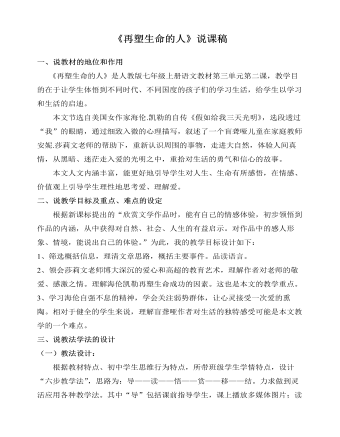
部编版语文七年级上册《再塑生命的人》说课稿
一、说教材的地位和作用《再塑生命的人》是人教版七年级上册语文教材第三单元第二课,教学目的在于让学生体悟到不同时代、不同国度的孩子们的学习生活,给学生以学习和生活的启迪。 本文节选自美国女作家海伦.凯勒的自传《假如给我三天光明》,选段透过“我”的眼睛,通过细致入微的心理描写,叙述了一个盲聋哑儿童在家庭教师安妮.莎莉文老师的帮助下,重新认识周围的事物,走进大自然,体验人间真情,从黑暗、迷茫走入爱的光明之中,重拾对生活的勇气和信心的故事。本文人文内涵丰富,能更好地引导学生对人生、生命有所感悟,在情感、价值观上引导学生理性地思考爱、理解爱。二、说教学目标及重点、难点的设定根据新课标提出的“欣赏文学作品时,能有自己的情感体验,初步领悟到作品的内涵,从中获得对自然、社会、人生的有益启示。对作品中的感人形象、情境,能说出自己的体验。”为此,我的教学目标设计如下:
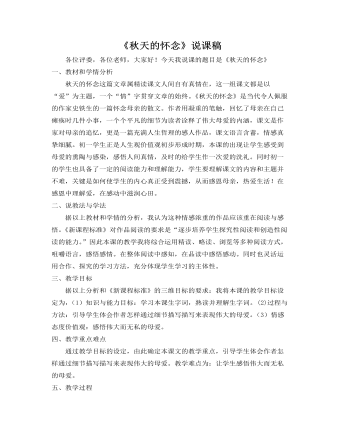
部编版语文七年级上册《秋天的怀念》说课稿
一、教材和学情分析秋天的怀念这篇文章属精读课文人间自有真情在,这一组课文都是以“爱”为主题,一个“情”字贯穿文章的始终。《秋天的怀念》是当代令人佩服的作家史铁生的一篇怀念母亲的散文。作者用凝重的笔触,回忆了母亲在自己瘫痪时几件小事,一个个平凡的细节为读者诠释了伟大母爱的内涵,课文是作家对母亲的追忆,更是一篇充满人生哲理的感人作品,课文语言含蓄,情感真挚细腻。初一学生正是人生观价值观初步形成时期,本课的出现让学生感受到母爱的熏陶与感染,感悟人间真情,及时的给学生作一次爱的洗礼。同时初一的学生也具备了一定的阅读能力和理解能力,学生要理解课文的内容和主题并不难,关键是如何使学生的内心真正受到震撼,从而感恩母亲,热爱生活!在感恩中理解爱,在感动中滋润心田。
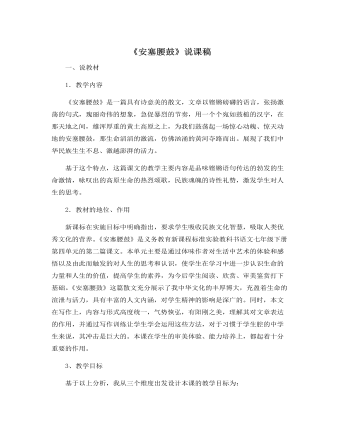
部编版语文八年级下册《安塞腰鼓》说课稿
1.教学内容《安塞腰鼓》是一篇具有诗意美的散文,文章以铿锵磅礴的语言,张扬激荡的句式,瑰丽奇伟的想象,急促暴烈的节奏,用一个个宛如鼓槌的汉字,在那天地之间,雄浑厚重的黄土高原之上,为我们鼓荡起一场惊心动魄、惊天动地的安塞腰鼓,那生命滔滔的激流,仿佛汹涌的黄河夺路而出。展现了我们中华民族生生不息、激越澎湃的活力。基于这个特点,这篇课文的教学主要内容是品味铿锵语句传达的勃发的生命激情,咏叹出的高原生命的热烈颂歌,民族魂魄的诗性礼赞,激发学生对人生的思考。2.教材的地位、作用新课标在实施目标中明确指出,要求学生吸收民族文化智慧,吸取人类优秀文化的营养。《安塞腰鼓》是义务教育新课程标准实验教科书语文七年级下册第四单元的第二篇课文。本单元主要是通过体味作者对生活中艺术的体验和感悟以及由此而触发的对人生的思考和认识,使学生在学习中进一步认识生命的力量和人生的价值,提高学生的素养,为今后学生阅读、欣赏、审美鉴赏打下基础。《安塞腰鼓》这篇散文充分展示了我中华文化的丰厚博大,充盈着生命的渲泄与活力,具有丰富的人文内涵,对学生精神的影响是深广的。
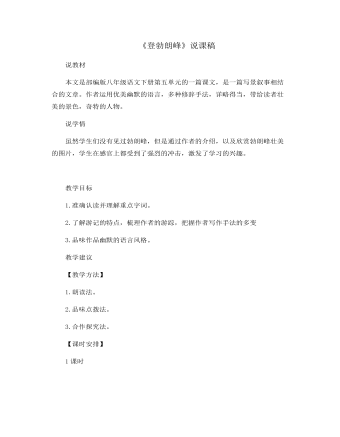
部编版语文八年级下册《登勃朗峰》说课稿
马克·吐温(1835-1910),美国幽默大师、小说家,19世纪后期美国现实主义文学的杰出代表之一。作品风格以幽默和讽刺为主,既富于独特的个人机智与妙语,又不乏深刻的社会洞察与剖析。主要的代表作品有《百万英镑》(短篇)等。此外,马克·吐温还有自己的四大名著:《哈克贝利·费恩历险记》《汤姆·索亚历险记》《败坏了哈德莱堡的人》《苦行记》等。勃朗峰是阿尔卑斯山脉最高峰,也是西欧第一高峰,海拔4807米,法语意为“银白色山峰”,位于法国和意大利边境。勃朗峰地势高耸,常年受西风影响,降水丰富。冬季积雪,夏不融化,白雪皑皑,山体约有200平方公里为冰川覆盖。勃朗峰设有空中缆车和冬季体育设施,为登山运动胜地;山峰雄伟,风光旖旎,为阿尔卑斯山最大旅游中心。勃朗峰下筑有公路隧道,起自法国的沙漠尼山谷到意大利的库马约尔,长11.6公里,1965年建成通车,使巴黎到罗马的里程缩短了约220公里。
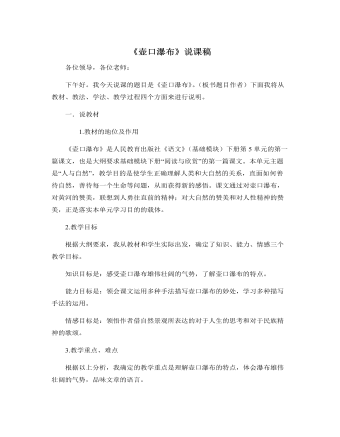
部编版语文八年级下册《壶口瀑布》说课稿
一.说教材1.教材的地位及作用《壶口瀑布》是人民教育出版社《语文》(基础模块)下册第5单元的第一篇课文,也是大纲要求基础模块下册“阅读与欣赏”的第一篇课文。本单元主题是“人与自然”,教学目的是使学生正确理解人类和大自然的关系,直面如何善待自然,善待每一个生命等问题,从而获得新的感悟。课文通过对壶口瀑布,对黄河的赞美,联想到人勇往直前的精神;对大自然的赞美和对人性精神的赞美,正是落实本单元学习目的的载体。2.教学目标根据大纲要求,我从教材和学生实际出发,确定了知识、能力、情感三个教学目标。知识目标是:感受壶口瀑布雄伟壮阔的气势,了解壶口瀑布的特点。能力目标是:领会课文运用多种手法描写壶口瀑布的妙处,学习多种描写手法的运用。情感目标是:领悟作者借自然景观所表达的对于人生的思考和对于民族精神的歌颂。
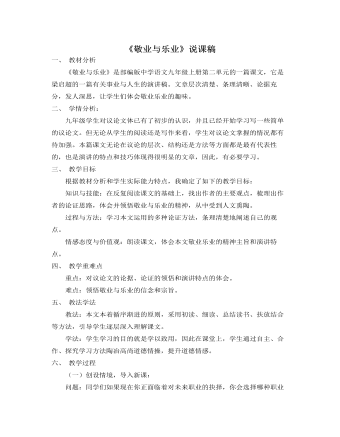
部编版语文九年级上册《敬业与乐业》说课稿
一、 教材分析《敬业与乐业》是部编版中学语文九年级上册第二单元的一篇课文,它是梁启超的一篇有关事业与人生的演讲稿。文章层次清楚、条理清晰、论据充分,发人深思,让学生们体会敬业乐业的趣味。二、 学情分析:九年级学生对议论文体已有了初步的认识,并且已经开始学习写一些简单的议论文。但无论从学生的阅读还是写作来看,学生对议论文掌握的情况都有待加强。本篇课文无论在议论的层次、结构还是方法等方面都是最有代表性的,也是演讲的特点和技巧体现得很明显的文章,因此,有必要学习。三、 教学目标根据教材分析和学生实际能力特点,我确定了如下的教学目标:知识与技能:在反复阅读课文的基础上,找出作者的主要观点,梳理出作者的论证思路,体会并领悟敬业与乐业的精神,从中受到人文熏陶。过程与方法:学习本文运用的多种论证方法,条理清楚地阐述自己的观点。

部编版语文八年级下册《一滴水经过丽江》说课稿
一、说教材:《一滴水经过丽江》这篇课文是作者应当地政府之约,为中学生写的一篇有关丽江的散文,义务教育教科书八年级下五单元新选的一篇游记散文,这是一篇别具一格游记,与一般游记作品以人的游踪为线索不同,作者化身为一滴水,以水的游踪为线索,展开对古城丽江自然风光,人文风情进行描绘,构思新颖,视觉独特。表现作者对丽江的喜爱和赞美二、教学目标:培养知识和技能:1.学习以物为叙述角度,按地点转换安排结构的写作手法2.体会作者以一滴水的视角去游览丽江的新颖构思。情感、态度与价值观培养热爱祖国风光,热爱祖国灿烂文化,为把祖国建设得更美好而努力学习。重点: 学习以物为叙述角度,按地点转换安排结构的写作手法难点: 会作者化身为一滴水经过丽江,介绍丽江的新颖构思和独特视角把握景物描写的特点
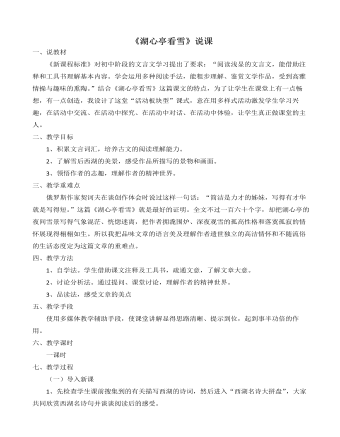
部编版语文九年级上册《湖心亭看雪》说课稿
一、说教材《新课程标准》对初中阶段的文言文学习提出了要求:“阅读浅显的文言文,能借助注释和工具书理解基本内容。学会运用多种阅读手法,能粗步理解、鉴赏文学作品,受到高雅情操与趣味的熏陶。”结合《湖心亭看雪》这篇课文的特点,为了让学生在课堂上有一点畅想,有一点创造,我设计了这堂“活动板块型”课式,意在用多样式活动激发学生学习兴趣,在活动中交流、在活动中探究、在活动中对话、在活动中体验,让学生真正做课堂的主人。二、教学目标1、积累文言词汇,培养古文的阅读理解能力。2、了解雪后西湖的美景,感受作品所描写的景物和画面。3、领悟作者的志趣,理解作者的精神世界。三、教学重难点俄罗斯作家契诃夫在谈创作体会时说过这样一句话:“简洁是力才的姊妹,写得有才华就是写得短。”这篇《湖心亭看雪》就是最好的证明。
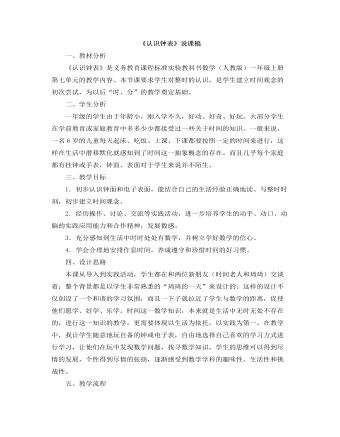
小学数学人教版一年级上册《认识钟表》说课稿
一、教材分析《认识钟表》是义务教育课程标准实验教科书数学(人教版)一年级上册第七单元的教学内容。本节课要求学生对整时的认识,是学生建立时间观念的初次尝试,为以后“时、分”的教学奠定基础。二、学生分析一年级的学生由于年龄小,刚入学不久,好动、好奇、好玩。大部分学生在学前教育或家庭教育中多多少少都接受过一些关于时间的知识。一般来说,一名6岁的儿童每天起床、吃饭、上课、下课都要按照一定的时间来进行,这样在生活中潜移默化就感知到了时间这一抽象概念的存在。而且几乎每个家庭都有挂钟或手表,钟面、表面对于学生来说并不陌生。三、教学目标 1.初步认识钟面和电子表面,能结合自己的生活经验正确地读、写整时时刻,初步建立时间观念。 2.经历操作、讨论、交流等实践活动,进一步培养学生的动手、动口、动脑的实践应用能力和合作精神,发展数感。
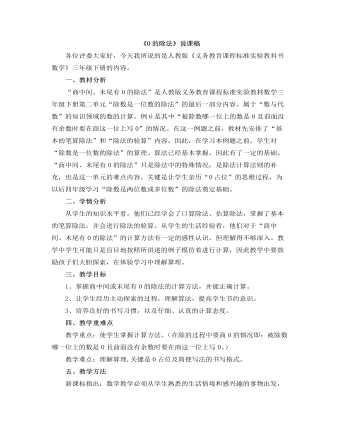
小学数学人教版三年级下册《0的除法》说课稿
一、教材分析“商中间、末尾有0的除法”是人教版义务教育课程标准实验教材数学三年级下册第二单元“除数是一位数的除法”的最后一部分内容。属于“数与代数”的知识领域的数的计算。例6是其中“被除数哪一位上的数是0且前面没有余数时要在商这一位上写0”的情况。在这一例题之前,教材先安排了“基本的笔算除法”和“除法的验算”内容。因此,在学习本例题之前,学生对“除数是一位数的除法”的算理、算法已经基本掌握,因此有了一定的基础。“商中间、末尾有0的除法”只是除法中的特殊情况,是除法计算法则的补充,也是这一单元的难点内容。关键是让学生亲历“0占位”的思维过程,为以后四年级学习“除数是两位数或多位数”的除法奠定基础。

小学数学人教版五年级下册《质数和合数》说课稿
设计意图:我运用了引导学生探究发现的教学方法,学生采用观察比较、分类归纳、讨论交流的学习方法。因为“质数和合数”是学生在学习了因数和倍数的基础上进行学习的。因此我抓住新旧知识的连接点,让学生找自己座号的因数,从学生身边熟悉的事物入手,唤起学生亲切的情感,激发他们学习的兴趣。学生是学习的主体,只有让学生参与知识的形成过程,数学知识才会内化学生自己的东西,四人小组讨论交流就是让学生在探讨中提高学习的能力。5、科学总结 实战练习(1)基本练习。完成“做一做”。 (2)强化练习。练习四第1、2题。 (3)综合练习。1-80质数表。验证刚才的判断是否正确。师:通过这节课的学习,你又有了什么新的收获? 你能帮甜甜解决箱子密码的问题了吗?
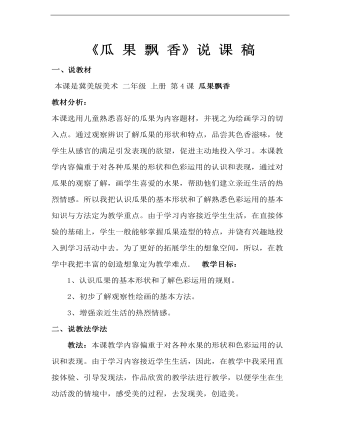
小学美术冀美版二年级上册《瓜果飘香》说课稿
教材分析:本课选用儿童熟悉喜好的瓜果为内容题材,并视之为绘画学习的切入点。通过观察辨识了解瓜果的形状和特点,品尝其色香滋味,使学生从感官的满足引发表现的欲望,促进主动地投入学习。本课教学内容偏重于对各种瓜果的形状和色彩运用的认识和表现,通过对瓜果的观察了解,画学生喜爱的水果,帮助他们建立亲近生活的热烈情感。所以我把认识瓜果的基本形状和了解熟悉色彩运用的基本知识与方法定为教学重点。由于学习内容接近学生生活,在直接体验的基础上,学生一般能够掌握瓜果造型的特点,并饶有兴趣地投入到学习活动中去。为了更好的拓展学生的想象空间,所以,在教学中我把丰富的创造想象定为教学难点.
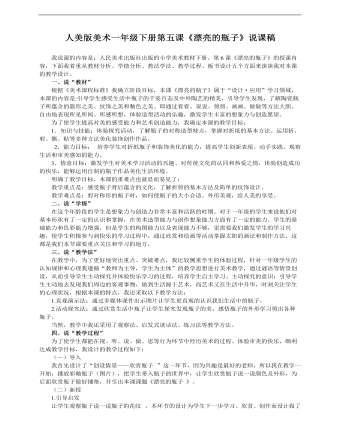
小学美术人美版一年级下册《漂亮的瓶子》说课稿
1.知识与技能:体验探究活动,了解瓶子的对称造型特点,掌握对折纸的基本方法。运用折、剪、撕、贴等多种方法美化装饰创作作品。 2.能力目标: 培养学生对折纸瓶子和装饰美化的能力,提高学生创新表现、动手实践、观察生活和审美感知的能力。3.情意目标:激发学生对美术学习活动的兴趣、对传统文化的认同和热爱之情,体验创造成功的快乐,能够运用自制的瓶子作品美化生活环境。明确了教学目标,本课的重难点也就显而易见了:教学重点是:感受瓶子背后蕴含的文化,了解折剪的基本方法及简单的纹饰设计。教学难点是:剪对称形的瓶子时,如何使瓶子的大小合适、外形美观,给人美的享受。
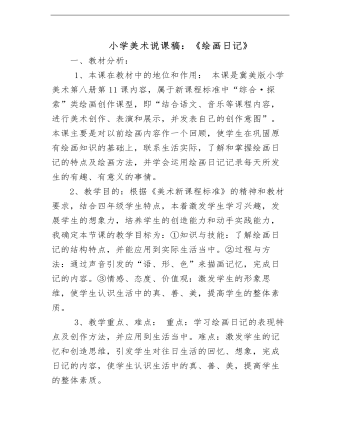
小学美术冀美版四年级下册《11绘画日记》说课稿
2、教学目的:根据《美术新课程标准》的精神和教材要求,结合四年级学生特点,本着激发学生学习兴趣,发展学生的想象力,培养学生的创造能力和动手实践能力,我确定本节课的教学目标为:①知识与技能:了解绘画日记的结构特点,并能应用到实际生活当中。②过程与方法:通过声音引发的“语、形、色”来描画记忆,完成日记的内容。③情感、态度、价值观:激发学生的形象思维,使学生认识生活中的真、善、美,提高学生的整体素质。
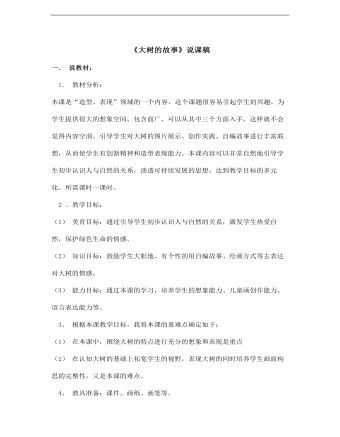
小学美术冀美版一年级下册《19大树的故事》说课稿
(1) 美育目标:通过引导学生初步认识人与自然的关系,激发学生热爱自然,保护绿色生命的情感。(2) 知识目标:鼓励学生大胆地、有个性的用自编故事、绘画方式等去表达对大树的情感。(3) 能力目标:通过本课的学习,培养学生的想象能力、儿童画创作能力、语言表达能力等。

